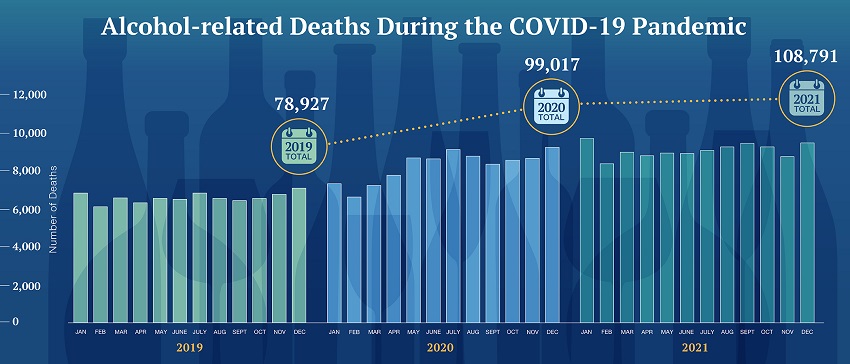The pandemic has affected us in so many ways and on so many levels, and its effects continue. It’s to be expected that a once-in-a-century event that claimed nearly 7 million lives globally and 1.1 million lives in the US has had such profound effects on everything from the economy and national health to the workplace and the ways we live our day-to-day lives.
Recently, George F. Koob, Ph.D., director of the National Institute on Alcohol Abuse and Alcoholism (NIAAA) spoke out about various health effects related to alcohol use during the pandemic. The National Institutes of Health interviewed Koob, issuing a release entitled Risky Alcohol Use: An Epidemic Inside the COVID-19 Pandemic.
He begins by noting something we probably could all guess: Drinking increases around the time of a crisis, There were spikes in drinking after such events as 9/11 and Hurricane Katrina. People turn to alcohol for relief from stress, so it could be expected that Covid-19 would be similar. But Koob points to one significant difference that people faced in the pandemic, and which probably heightened the rate of drinking: social isolation.
He says:
It was really no surprise that during the first year of the pandemic, alcohol sales jumped by nearly 3%, the largest increase in more than 50 years. Multiple small studies suggest that during the pandemic, about 25% of people drank more than usual, often to cope with stress. Sales of hard liquor, or spirits, accounted for most of the increase.
When asked if researchers found any trends in alcohol-related deaths and health problems during the pandemic, Koob said:
Yes, we’ve certainly been seeing higher levels of disease and death linked with alcohol use, and it’s pretty dramatic. During the first 2 years of the pandemic, the number of death certificates listing alcohol as a factor soared from 78,927 to 108,791 — an increase of nearly 38%. We saw the largest increases in deaths related to drinking among people between the ages of 25 and 44.
We’ve also seen more people end up in hospitals due to alcohol misuse and its consequences, including withdrawal symptoms and liver disease. People seeking liver transplants because of alcohol misuse are younger than ever, with many transplant centers reporting that some of their patients haven’t even reached the age of 30. Unfortunately, deaths due to alcohol-linked liver disease increased by more than 22% during the pandemic.

Long-term effects of pandemic-related alcohol use spike?
In addition to isolation being a factor, the duration of the pandemic must also be considered. When asked what the long-term consequences of pandemic-related alcohol misuse might be, Koob noted that:
- Some people will have trouble cutting back on their drinking and will have a higher risk of Alcohol Use Disorder (AUD).
- Children may have been exposed to unhealthy behaviors related to alcohol use. This could influence their future risk for problem drinking.
- Many policy changes and trends such as a loosening of restrictions of online alcohol sales are likely to continue long after the pandemic ends, increasing the risk of alcohol-related problems.
He notes that in past disasters, spikes in drinking last 5 or 6 years and then alcohol consumption slowly returns to usual levels.
Another troubling trend in alcohol use: Alcohol-related deaths on the rise for women
Women are often seeking parity with men, and by one unfortunate metric, they appear to be gaining ground, CNN recently reported the rate of alcohol-related deaths for women is rising, and the rate is rising faster than that of men, as per a study in JAMA: Trends in Alcohol-Related Deaths by Sex in the US, 1999-2020.
For men, the rate of alcohol-related deaths has been on the rise since 2009, with particularly sharp increases each year since 2018. But the upward trend for women started at least a decade earlier and has been rising faster, on average, each year since.
From 2018 to 2020, the alcohol-related death rate among men increased by an average of 12.5% each year. But for women, rates surged by an average of nearly 15% each year in that same time period.
Researchers analyzed CDC data, which tracks underlying causes of death. Alcohol-related deaths included alcohol-related poisoning, liver disease, gastritis, and others. However, these may not encompass all alcohol-relate deaths such as those homicides, accidents, and others that may have been indirectly or partially related to alcohol use.
Help Resources
Related blog posts:
Other help resources
